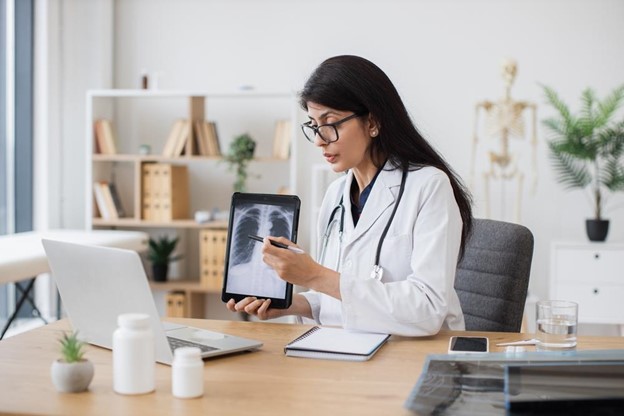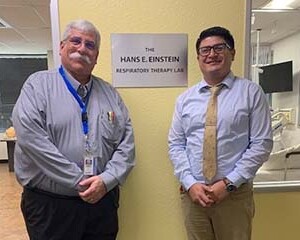The Benefits of Pulmonary Rehabilitation in Respiratory Care

Lung disease is a common problem with a surprisingly far-reaching impact. According to the American Lung Association, more than 34 million people in the United States deal with some sort of chronic lung condition.[1] These lung concerns range in severity—with some adding unwanted complications to everyday activities, while others lead to hospitalization or even death.
No matter how severe their suffering, every person diagnosed with a lung disease or disorder deserves targeted treatments designed to make their lives easier and more comfortable.
Therein lies the value of pulmonary rehabilitation, which represents one of the most promising solutions in modern pulmonology. Intended to increase lung capacity and reduce feelings of breathlessness, this nuanced strategy provides hope for a variety of patients who would otherwise be forced to rely on more invasive solutions such as medications or surgery. Despite its great promise, however, pulmonary rehab remains an underutilized strategy, in part because those who most stand to benefit from it may have no idea this is even an option.
In this guide, we provide a deep dive into this exciting solution while answering essential questions: What is pulmonary rehabilitation, and why is it important? Discover the power of pulmonary rehab and the role respiratory therapists can play in facilitating this promising solution.
Understanding Respiratory Conditions and Quality of Life
If you do not suffer from a respiratory illness, you may forget just how wonderful it is to breathe easily. This seemingly simple mechanism allows us to participate in all the activities we love, hobbies, playing with our kids, or walking the dog. In motion or at rest, the ability to breathe without obstacle should spark gratitude. As this becomes more difficult, one’s quality of life diminishes dramatically.
How It Affects Daily Life
Respiratory conditions play into every area of daily life, creating not only physical problems but also an extra burden as sufferers try to determine how they’ll deal with their limitations. Often, symptoms go beyond the lungs or the sensations of breathing to include concerns that influence many other body parts and systems.
Examples of respiratory-induced problems that occur throughout the day include:
- Limited energy, even after getting a decent night’s sleep.
- Chronic coughing, sometimes involving phlegm.
- Difficulty with domestic tasks such as cleaning or meal preparation.
- Lack of motivation to exercise, including low-intensity activities such as walking.
- Swelling of the ankles of the feet.
In addition to these daily struggles, many people with lung diseases experience a phenomenon known as exacerbations, in which baseline symptoms become far worse for a few days.[2] Even when exacerbations are not present, though, the condition can slowly worsen over time, as symptoms make many patients less inclined to engage in physical activity; this, in turn, reduces fitness levels and makes it even more difficult to breathe.
What Is Pulmonary Rehabilitation?
Pulmonary rehabilitation is a medical program designed to improve the daily lives of people suffering from various lung diseases. This program focuses on two main strategies: education and exercise. The process revolves around group classes to educate and motivate patients as well as provide a sense of community and much-needed accountability.[3]
Additionally, pulmonary rehabilitation calls for a strong medical team of physicians, physical therapists, respiratory therapists, and dietitians. Together, these healthcare professionals provide in-depth insight into the everyday routines that might reduce or exacerbate symptoms.
Pulmonary rehab generally functions as an outpatient program and may take place in specialty clinics or at hospitals. Some aspects of pulmonary rehab can be completed from the comfort of home, and in response to COVID, more elements have been made available virtually, too.
Education About Lungs
Education is a central component of pulmonary rehabilitation. This program adopts the stance that patients will be more empowered to manage their symptoms if they know how their lungs work and why they are suffering. Typical topics addressed during education sessions include:
- The anatomy of the respiratory system.
- The pathophysiology of lung diseases.
- The influence of physical activity on lung disease symptoms.
- The most commonly prescribed drugs and their potential side effects.
- Mental health topics such as stress management, depression, and anxiety.
Exercise to Improve Shortness of Breath
No amount of education will have a lasting impact if patients continue to struggle with exceedingly low lung capacity that causes near-constant shortness of breath. This is where the other main component of pulmonary rehab comes into play: exercise with the primary intention of avoiding distressing sensations like shortness of breath.
Many patients with lung diseases instinctively know they need to exercise on a regular basis but struggle to actually get started. Pulmonary rehab provides a clear boost, bringing a sense of accountability along with a much-needed element of fun and lightheartedness into the exercise process. Participants may eventually come to look forward to their exercise sessions.
Through guided exercises, patients also learn strategies for increasing lung capacity without suffering significant discomfort along the way. Certain exercises may be recommended over others, with patients instructed on how to perform these properly. Equipped with this knowledge, patients are more likely to continue completing suggested exercise regimens on their own.
Overall Benefits of Pulmonary Rehabilitation
A growing body of research suggests that pulmonary rehabilitation can lead to a myriad of physical, mental, and even financial benefits while also avoiding the downsides that so frequently accompany other lung disease treatment or management strategies. We highlight a few of the most meaningful advantages below:
Improved Lung Function
By committing to targeted exercises, pulmonary rehab participants could experience considerable enhancements in general lung function. Promising research published in Respiratory Medicine Case Reports suggests that lung function can see impressive improvements among COPD patients undergoing pulmonary rehab. This is especially true in regard to forced expiratory volume (FEV1), which represents the amount of air patients are capable of forcing from their lungs in one second.[4]
More Endurance in Fitness
As lung function improves, pulmonary rehab participants find that they can once again enjoy the physical activities they were previously forced to set aside. Endurance increases remarkably throughout the course of the program and can continue to improve afterward, as participants feel more confident about their physical performance and are more willing to exercise regularly. This creates an upward spiral of advantages, as more frequent exercise leads to even better lung function.
Symptom Management
Pulmonary rehabilitation does not represent a permanent cure; unfortunately, if patients start slacking on recommended exercises, the benefits of these programs may begin to diminish. Still, the education imparted by instructional sessions can equip and empower patients to take matters into their own hands and hopefully get their symptoms under better control.
Through targeted instruction, patients can learn to recognize when they are suffering symptoms, which situations trigger or exacerbate them, and which strategies are most likely to help—both in the short term and far into the future.
Peer Support Group
Peer support is a key component of any pulmonary rehab program. This is mainly promoted in a group setting, where a core group of patients regularly attend both education and exercise sessions. These fellow patients provide a powerful source of emotional release and validation, reminding those with lung diseases that they are not alone and that, together, they have the power to overcome their worst symptoms and lead enjoyable lives.
Improving Quality of Life
The many benefits described above coalesce to create one main advantage of participating in pulmonary rehab: a dramatically heightened quality of life. Through pulmonary rehab, patients come to feel not only physically better but also more confident in their abilities and more hopeful about the future. Add new friends to the mix, and it’s easy to see why pulmonary rehab is increasingly regarded as an effective option for addressing mental health concerns in patients.
Who Can Benefit from Pulmonary Rehabilitation?
A range of patients can benefit from pulmonary rehab. This solution was designed to help patients with severe lung conditions that negatively impact them on a daily basis. Unfortunately, access is a major barrier that keeps many deserving patients from getting the help they need.
A report published in the journal Life reveals that, on a global scale, a mere 3 percent of people with chronic lung diseases are able to take advantage of pulmonary rehab.[5] The report indicates the vital need for improved access, given the strong potential of pulmonary rehab to manage their symptoms and enhance their quality of life.
The good news? Awareness of pulmonary rehab is expanding, with more patients realizing they can benefit from it and practitioners developing the necessary skills and knowledge to implement these programs. When pulmonary rehab is available, it is typically provided for patients dealing with a few central health concerns:
Lung Disease
The term lung disease refers to a wide array of disorders affecting the lungs that make it more difficult to breathe. Examples of lung diseases include:
- Pulmonary fibrosis
- Pneumonia
- Lung cancer
COPD
Chronic obstructive pulmonary disease (COPD) describes a number of illnesses and conditions that block airflow and cause breathing difficulties. This umbrella term covers well-known breathing concerns, such as chronic bronchitis and emphysema.
According to the Centers for Disease Control and Prevention (CDC), 16 million Americans suffer from COPD.[6] Although COPD is technically a type of lung disease, it has a distinctly chronic element that calls for management strategies such as pulmonary rehab.
Make a Difference as a Respiratory Therapist
Learn how to become a respiratory therapist through SJVC and have an impact on the quality of people’s lives. Our Associate of Science in Respiratory Therapy program could provide the ultimate start to a rewarding career.
You might also like
More stories about
Request Information
All fields using an asterik (*) are required.
Sources
[1] “Our Impact.” American Lung Association. https://www.lung.org/about-us/our-impact#
[2] “Prevent COPD Exacerbations or Flare Ups.” American Lung Association. https://www.lung.org/lung-health-diseases/lung-disease-lookup/copd/living-with-copd/prevent-flare-ups
[3] “Pulmonary Rehabilitation.” National Heart, Blood, and Lung Institute. https://www.nhlbi.nih.gov/health/pulmonary-rehabilitation
[4] Incorvaia, C. et al. “About the effect of pulmonary rehabilitation on lung function in patients with chronic obstructive pulmonary disease.” Respiratory Medicine Case Report. https://www.ncbi.nlm.nih.gov/pmc/articles/PMC4961741/
[5] Lahham, A. and Holland, A. “The Need for Expanding Pulmonary Rehabilitation Services.” Life. https://www.ncbi.nlm.nih.gov/pmc/articles/PMC8622005/
[6] “Chronic Obstructive Pulmonary Disease (COPD).” Centers for Disease Control and Prevention. https://www.cdc.gov/copd/index.html


